2018 TOYOTA YARIS iA sensor
[x] Cancel search: sensorPage 4 of 576

TABLE OF CONTENTS4
YARIS iA_OM_OM99Q46z_(U)3-6. ABS/TCS/DSC
Antilock Brake System (ABS) .............................. 193
Traction Control System (TCS) .............................. 194
Dynamic Stability Control (DSC) .............................. 196
3-7. Fuel Economy Monitor Fuel Economy Monitor ...... 199
3-8. Drive Selection Drive Selection (Automatic Transaxle) ..... 201
3-9. Power Steering Power Steering.................. 203
3-10. Active Safety System Active Safety System ........ 204
Smart City Brake Support (SCBS) ............................ 205
Laser Sensor ..................... 211
3-11. Cruise Control Cruise Control ................... 213
3-12. Tire Pressure Monitoring System
Tire Pressure Monitoring System ............................ 218
3-13. Rear View Monitor Rear View Monitor............. 222 4-1. Climate Control System
Operating Tips ................... 234
Vent Operation .................. 235
Manual Type ...................... 237
4-2. Audio System Antenna ............................. 244
Operating Tips for Audio System ............................ 245
Audio Set (Type A [non-touchscreen]) .......... 258
Audio Set (Type B [touchscreen]).................. 274
Audio Control Switch Operation......................... 295
AUX/USB mode ................. 298
4-3. Bluetooth
®
Bluetooth®......................... 319
Bluetooth® Hands-Free
(Type A)........................... 354
Bluetooth
® Hands-Free
(Type B)........................... 365
Bluetooth
® Audio
(Type A)........................... 378
Bluetooth
® Audio
(Type B)........................... 382
Troubleshooting ................. 395
4-4. Interior Equipment Sunvisors ........................... 400
Interior Lights ..................... 401
Accessory Sockets ............ 404
Cup Holder ........................ 405
Bottle Holder ...................... 406
Storage Compartments ..... 407
4Interior Features
Page 36 of 576
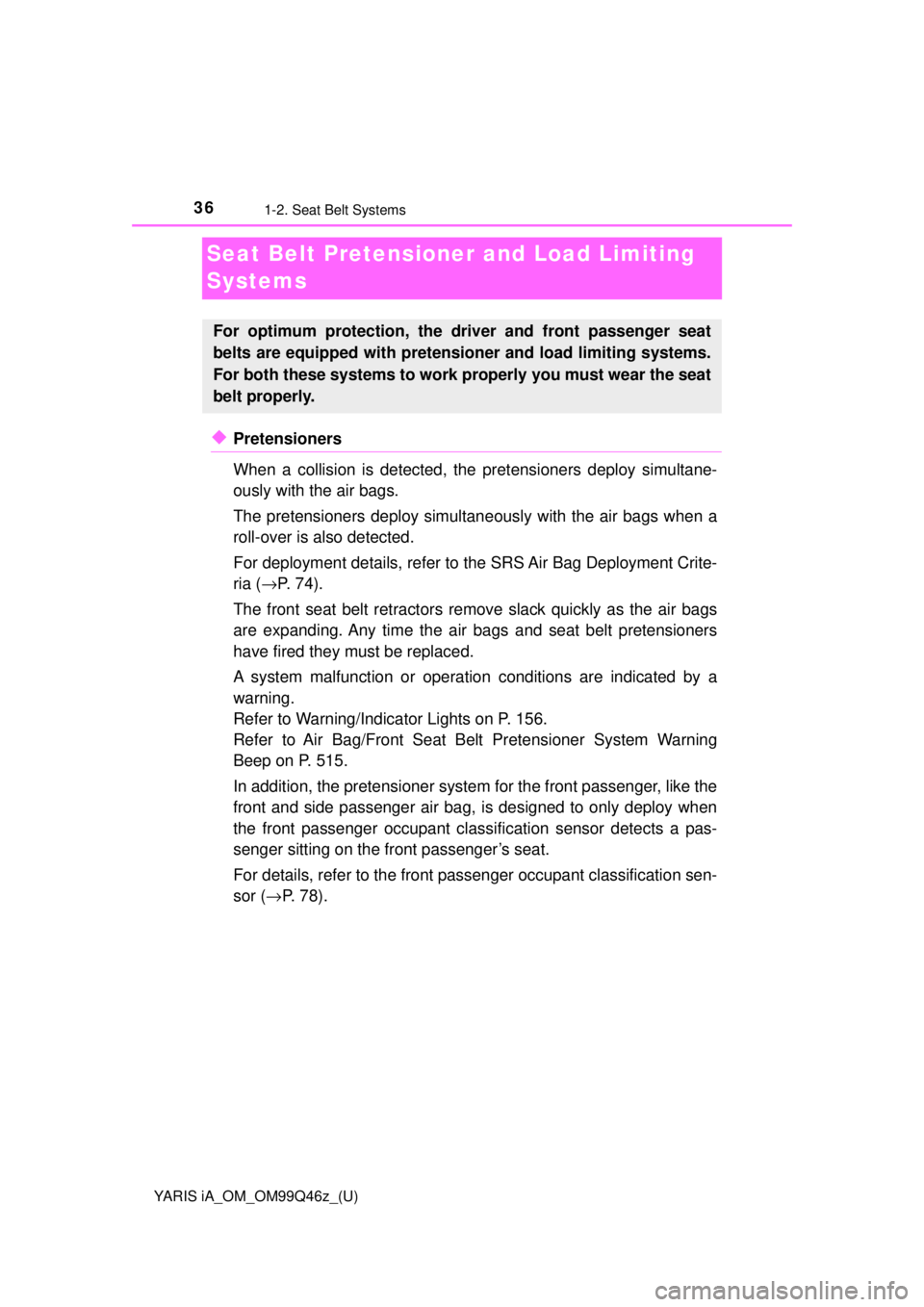
36
YARIS iA_OM_OM99Q46z_(U)
1-2. Seat Belt Systems
Seat Belt Pretensioner and Load Limiting
Systems
◆Pretensioners
When a collision is dete cted, the pretensioners deploy simultane-
ously with the air bags.
The pretensioners deploy simultan eously with the air bags when a
roll-over is also detected.
For deployment details, refer to the SRS Air Bag Deployment Crite-
ria ( →P. 74).
The front seat belt retractors remove slack quickly as the air bags
are expanding. Any time the air ba gs and seat belt pretensioners
have fired they must be replaced.
A system malfunction or operation conditions are indicated by a
warning.
Refer to Warning/Indicator Lights on P. 156.
Refer to Air Bag/Front Seat Belt Pretensioner System Warning
Beep on P. 515.
In addition, the pretensioner syst em for the front passenger, like the
front and side passenger air bag, is designed to only deploy when
the front passenger occupant clas sification sensor detects a pas-
senger sitting on the front passenger’s seat.
For details, refer to the front passenger occupant classification sen-
sor ( →P. 7 8 ) .
For optimum protection, the driver and front passenger seat
belts are equipped with pretensi oner and load limiting systems.
For both these systems to work properly you must wear the seat
belt properly.
Page 41 of 576
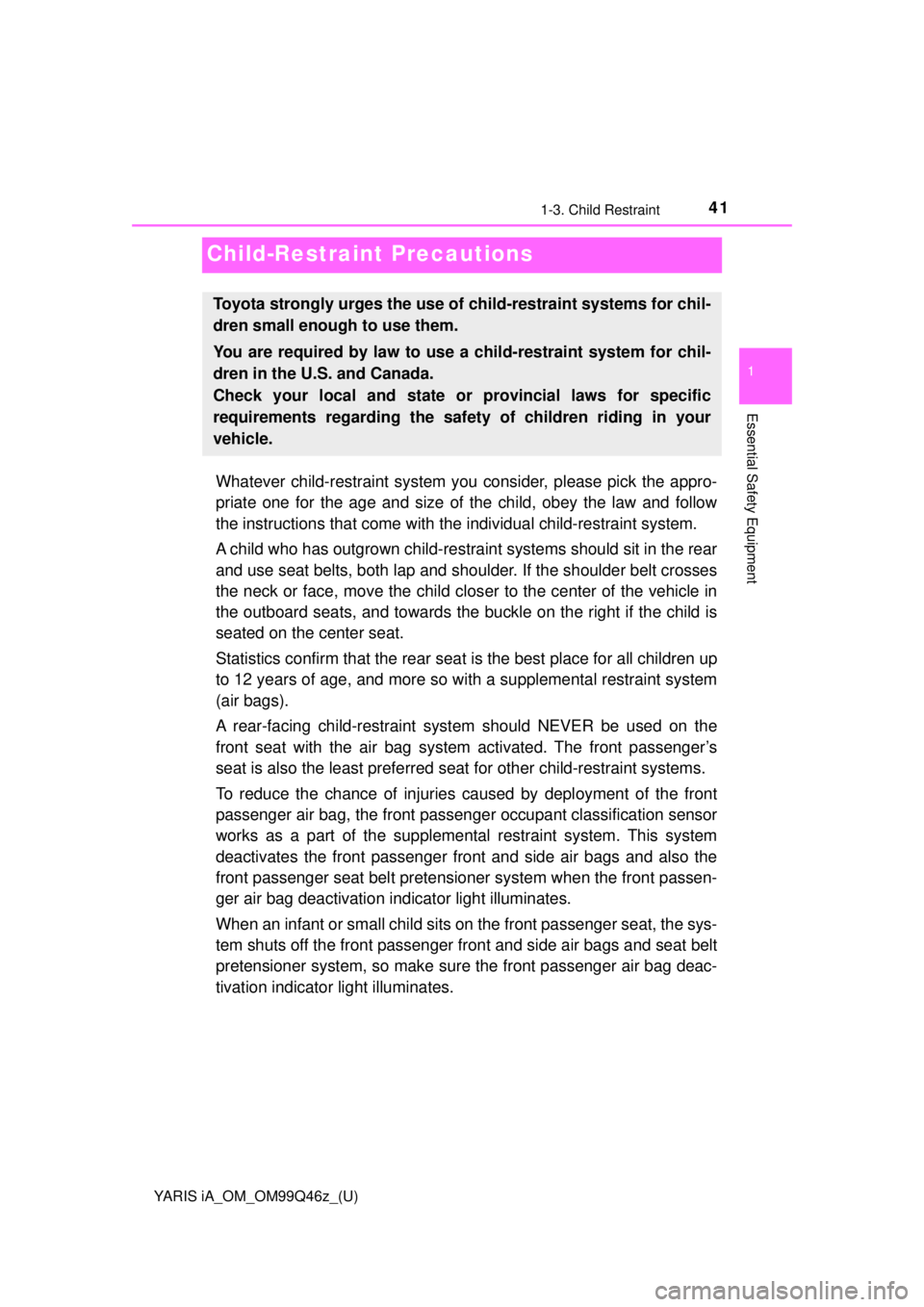
41
YARIS iA_OM_OM99Q46z_(U)
1-3. Child Restraint
1
Essential Safety Equipment
Child-Restraint Precautions
Whatever child-restraint system you consider, please pick the appro-
priate one for the age and size of the child, obey the law and follow
the instructions that come with the individual child-restraint system.
A child who has outgrown child-restra int systems should sit in the rear
and use seat belts, both lap and shoulder. If the shoulder belt crosses
the neck or face, move the child clos er to the center of the vehicle in
the outboard seats, and towards the buckle on the right if the child is
seated on the center seat.
Statistics confirm that the rear seat is the best place for all children up
to 12 years of age, and more so with a supplemental restraint system
(air bags).
A rear-facing child-restraint syst em should NEVER be used on the
front seat with the air bag system activated. The front passenger’s
seat is also the least preferred seat for other child-restraint systems.
To reduce the chance of injuries caused by deployment of the front
passenger air bag, the front passen ger occupant classification sensor
works as a part of the supplement al restraint system. This system
deactivates the front passenger front and side air bags and also the
front passenger seat bel t pretensioner system when the front passen-
ger air bag deactivation indicator light illuminates.
When an infant or small child sits on the front passenger seat, the sys-
tem shuts off the front passenger front and side air bags and seat belt
pretensioner system, so make sure the front passenger air bag deac-
tivation indicator light illuminates.
Toyota strongly urges the use of child-restraint systems for chil-
dren small enough to use them.
You are required by law to use a child-restraint system for chil-
dren in the U.S. and Canada.
Check your local and state or provincial laws for specific
requirements regarding the safety of children riding in your
vehicle.
Page 42 of 576

42
YARIS iA_OM_OM99Q46z_(U)
1-3. Child Restraint
Even if the front passenger air bag is shut off, Toyota strongly recom-
mends that children be properly restrained and child-restraint systems
of all kinds are properly secured on the rear seats which are the best
place for children.
For more details, refer to “Front passenger occupant classification
sensor” ( →P. 78).
Your Toyota is equipped with LATCH lower anchors for attachment of spe-
cially designed LATCH child-restraint systems in the rear seats. When using
these anchors to secure a child-restraint system, refer to “Using LATCH
Lower Anchor” (→P. 57).
WARNING
■Use the correct size child-restraint system
For effective protection in vehicle accidents and sudden stops, a child must
be properly restrained using a seat belt or child-restraint system depending
on age and size. If not, the child could be seriously injured or even killed in
an accident.
■ Follow the manufacturer’s instru ctions and always keep the child-
restraint system buckled down
An unsecured child-restraint system is dangerous. In a sudden stop or a
collision it could move causing serious injury or death to the child or other
occupants. Make sure any child-restraint system is properly secured in
place according to the child-restraint system manufacturer’s instructions.
When not in use, remove it from the vehicle or fasten it with a seat belt, or
latch it down to BOTH LATCH lower anchors for LATCH child-restraint sys-
tems and the corresponding tether anchor.
■ Always secure a child in a proper child-restraint system
Holding a child in your arms while the vehicle is moving is extremely dan-
gerous. No matter how strong the person may be, he or she cannot hold
onto a child in a sudden stop or collision and it could result in serious injury
or death to the child or other occupants. Even in a moderate accident, the
child may be exposed to air bag forces that could result in serious injury or
death to the child, or the child may be slammed into an adult, causing injury
to both child and adult.
Page 44 of 576
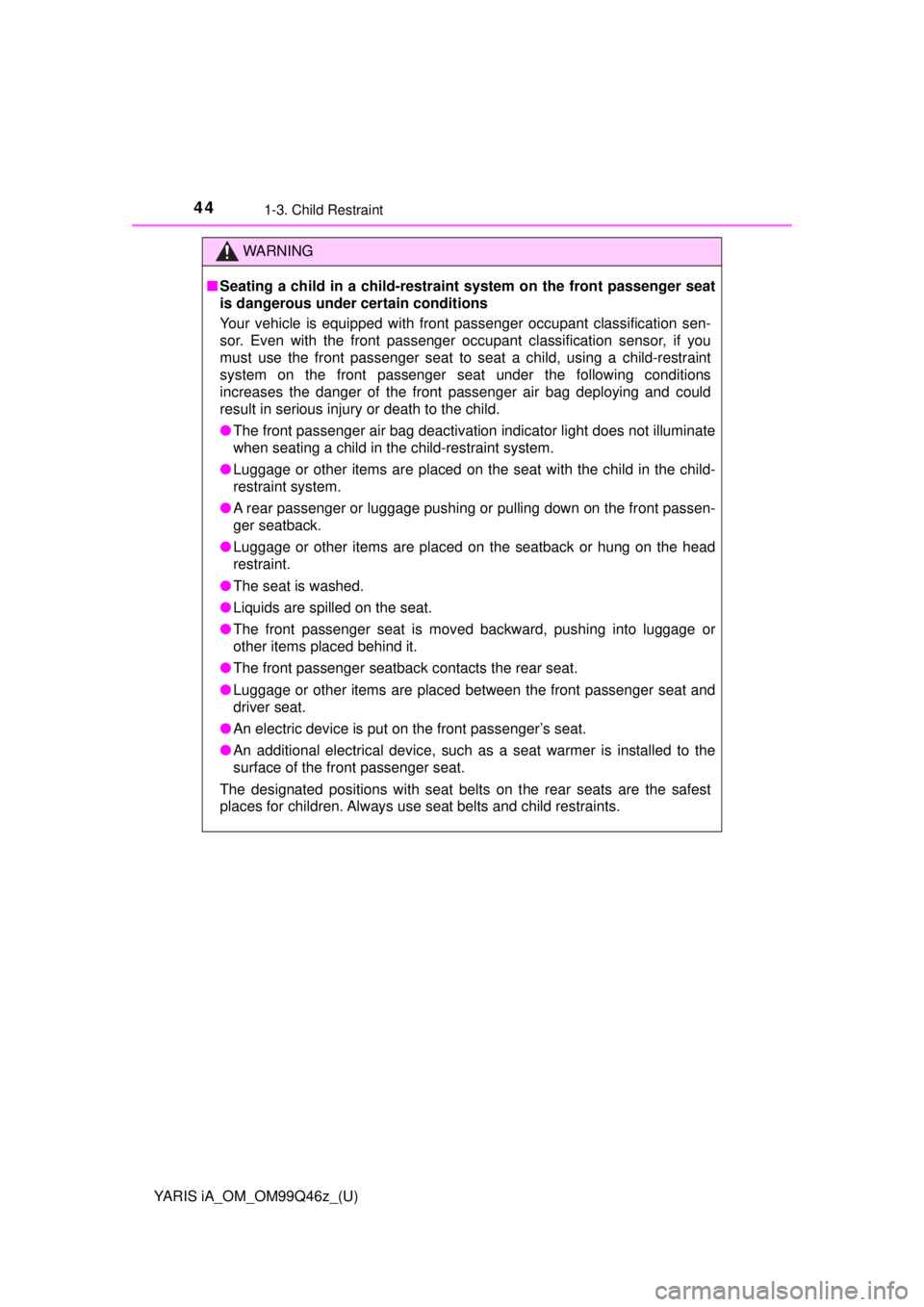
44
YARIS iA_OM_OM99Q46z_(U)
1-3. Child Restraint
WARNING
■Seating a child in a child-restra int system on the front passenger seat
is dangerous under certain conditions
Your vehicle is equipped with front passenger occupant classification sen-
sor. Even with the front passenger occupant classification sensor, if you
must use the front passenger seat to seat a child, using a child-restraint
system on the front passenger seat under the following conditions
increases the danger of the front passenger air bag deploying and could
result in serious injury or death to the child.
● The front passenger air bag deactivation indicator light does not illuminate
when seating a child in the child-restraint system.
● Luggage or other items are placed on the seat with the child in the child-
restraint system.
● A rear passenger or luggage pushing or pulling down on the front passen-
ger seatback.
● Luggage or other items are placed on the seatback or hung on the head
restraint.
● The seat is washed.
● Liquids are spilled on the seat.
● The front passenger seat is moved backward, pushing into luggage or
other items placed behind it.
● The front passenger seatback contacts the rear seat.
● Luggage or other items are placed between the front passenger seat and
driver seat.
● An electric device is put on the front passenger’s seat.
● An additional electrical device, such as a seat warmer is installed to t\
he
surface of the front passenger seat.
The designated positions with seat belts on the rear seats are the safest
places for children. Always use seat belts and child restraints.
Page 48 of 576
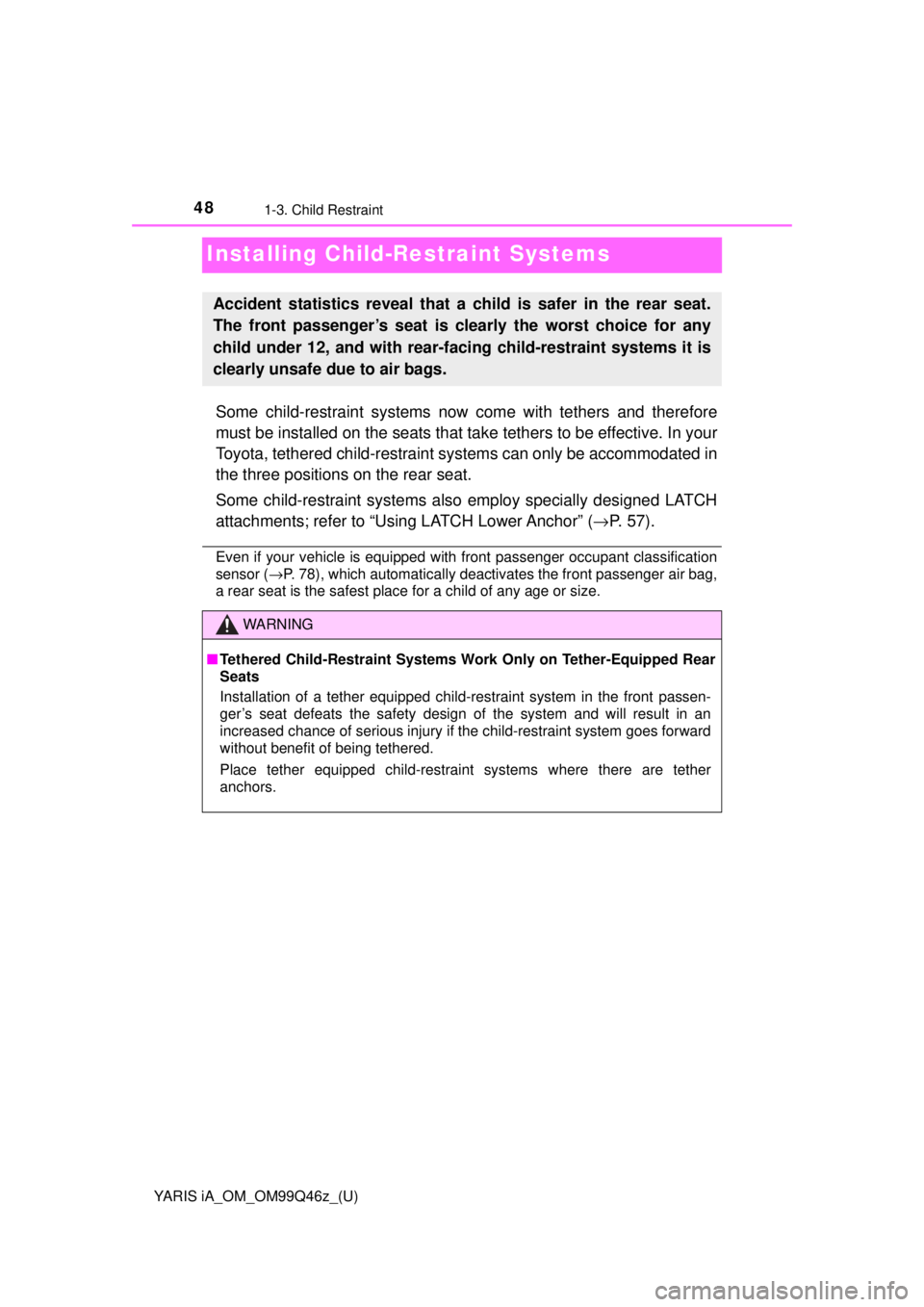
48
YARIS iA_OM_OM99Q46z_(U)
1-3. Child Restraint
Installing Child-Restraint Systems
Some child-restraint systems now come with tethers and therefore
must be installed on the seats that ta ke tethers to be effective. In your
Toyota, tethered child-restraint sy stems can only be accommodated in
the three positions on the rear seat.
Some child-restraint systems also employ specially designed LATCH
attachments; refer to “Using LATCH Lower Anchor” ( →P. 5 7 ) .
Even if your vehicle is equipped with front passenger occupant classification
sensor ( →P. 78), which automatically deactivates the front passenger air bag,
a rear seat is the safest place for a child of any age or size.
Accident statistics reveal that a child is safer in the rear seat.
The front passenger’s seat is clearly the worst choice for any
child under 12, and with rear-faci ng child-restraint systems it is
clearly unsafe due to air bags.
WARNING
■ Tethered Child-Restraint Systems Work Only on Tether-Equipped Rear
Seats
Installation of a tether equipped child-restraint system in the front passen-
ger’s seat defeats the safety design of the system and will result in an
increased chance of serious injury if the child-restraint system goes forward
without benefit of being tethered.
Place tether equipped child-restraint systems where there are tether
anchors.
Page 53 of 576
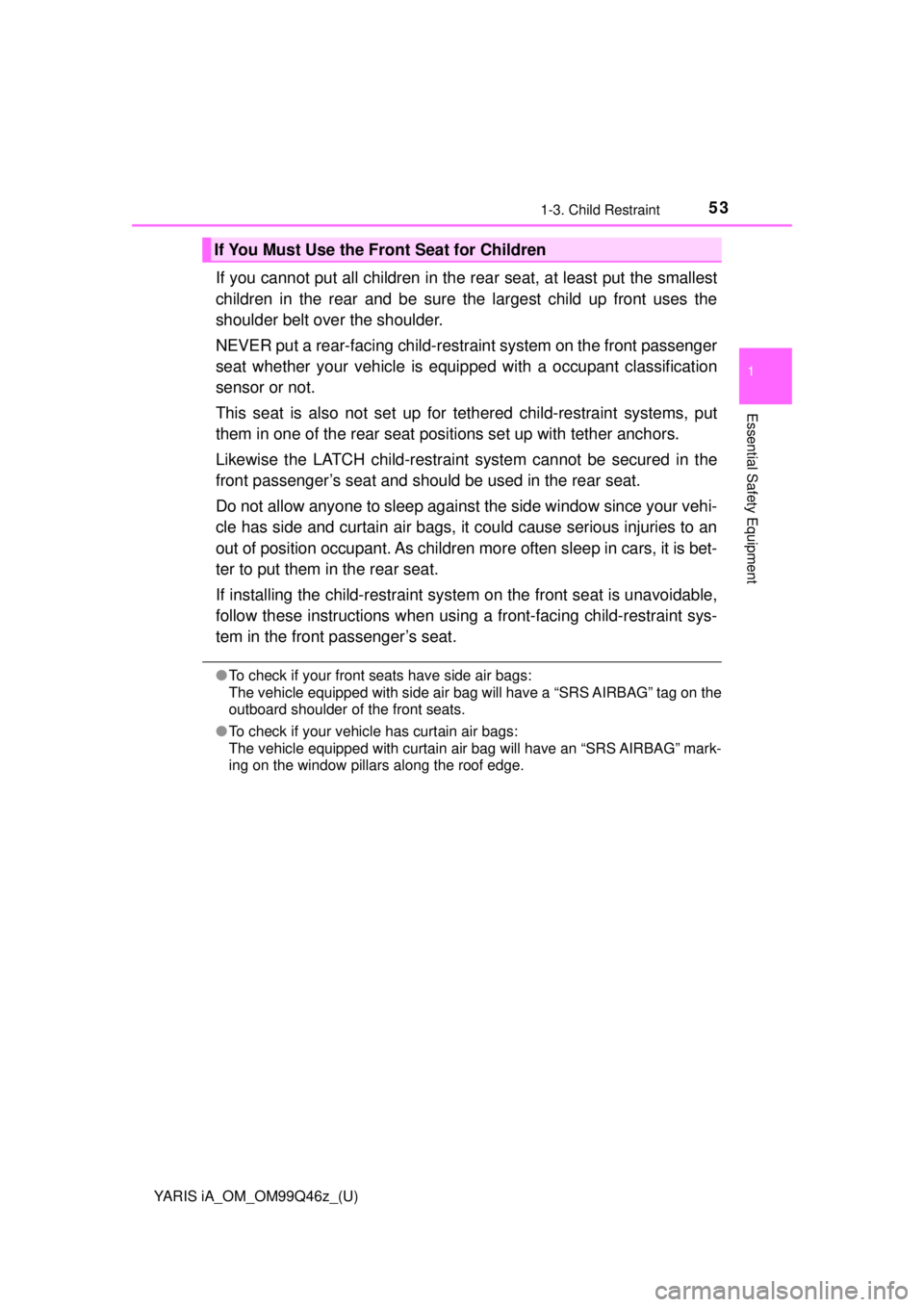
YARIS iA_OM_OM99Q46z_(U)
531-3. Child Restraint
1
Essential Safety Equipment
If you cannot put all children in the rear seat, at least put the smallest
children in the rear and be sure the largest child up front uses the
shoulder belt over the shoulder.
NEVER put a rear-facing child-restr aint system on the front passenger
seat whether your vehicle is equi pped with a occupant classification
sensor or not.
This seat is also not set up for te thered child-restraint systems, put
them in one of the rear seat pos itions set up with tether anchors.
Likewise the LATCH child-restraint system cannot be secured in the
front passenger’s seat and should be used in the rear seat.
Do not allow anyone to sleep against the side window since your vehi-
cle has side and curtain air bags, it could cause serious injuries to an
out of position occupant. As children mo re often sleep in cars, it is bet-
ter to put them in the rear seat.
If installing the child-restraint syst em on the front seat is unavoidable,
follow these instructions when usin g a front-facing child-restraint sys-
tem in the front passenger’s seat.
● To check if your front seats have side air bags:
The vehicle equipped with side air bag will have a “SRS AIRBAG” tag on the
outboard shoulder of the front seats.
● To check if your vehicle has curtain air bags:
The vehicle equipped with curtain air bag will have an “SRS AIRBAG” mark-
ing on the window pillars along the roof edge.
If You Must Use the Front Seat for Children
Page 66 of 576

66
YARIS iA_OM_OM99Q46z_(U)
1-4. SRS Air Bags
WARNING
■Do not touch the components of the supplemental restraint system
after the air bags have inflated
Touching the components of the supplemental restraint system after the air
bags have inflated is dangerous. Immediately after inflation, they are very
hot. You could get burned.
■ Never install any front-end equipment to your vehicle
Installation of front-end equipment, such as frontal protection bar (kangaroo
bar, bull bar, push bar, or other similar devices), snowplow, or winches, is
dangerous. The air bag crash sensor system could be affected. This could
cause air bags to inflate unexpectedly, or it could prevent the air bags from
inflating during an accident. Front occupants could be seriously injured.
■ Do not modify the suspension
Modifying the vehicle suspension is dangerous. If the vehicle’s height or the
suspension is modified, the vehicle will be unable to accurately detect a col-
lision or roll-over accident resulting in incorrect or unexpected air bag
deployment and the possibility of serious injuries.
■ To prevent false detection by the air bag sensor system, heed the fol-
lowing
● Do not use tires or wheels other than those specified for your Toyota:
Use of any tire or wheel other than those specified for your Toyota ( →P. 560)
is dangerous. Use of such wheels will prevent the vehicle’s accident detec-
tions system from accurately detecting a collision or roll-over accident result-
ing in incorrect or unexpected air bag deployment and the possibility of
serious injuries.
● Do not overload your vehicle:
Overloading your vehicle is dangerous as it could prevent the air bag
crash sensor system from accurately detecting a collision or roll-over acci-
dent resulting in incorrect or unexpected air bag deployment and the pos-
sibility of serious injuries. The gross axle weight rating (GAWR) and the
gross vehicle weight rating (GVWR) for your vehicle are on the Motor
Vehicle Safety Standard Label on the driver’s door frame. Do not exceed
these ratings.
● Do not drive the vehicle off-road:
Driving your Toyota off-road is dangerous because the vehicle has not
been designed to do so. Driving the vehicle off-road could prevent the air
bag crash sensor system from accurately detecting a collision or roll-over
accident resulting in incorrect or unexpected air bag deployment and the
possibility of serious injuries.